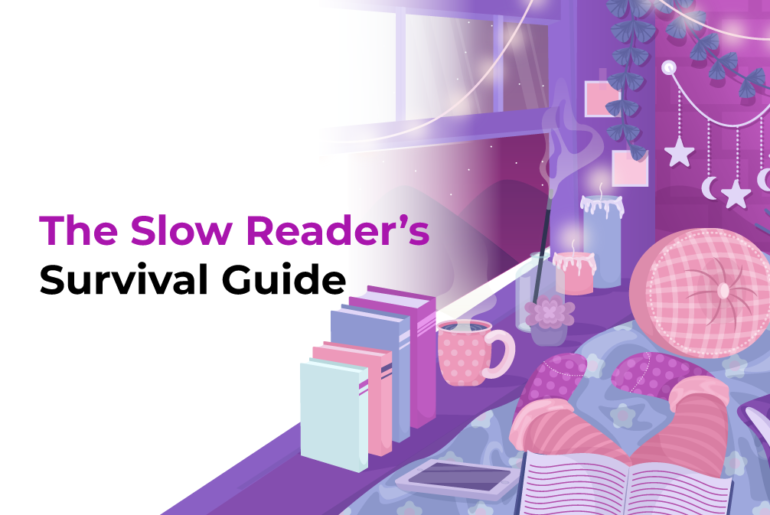If you’re struggling with how to read Shakespeare, then you are in the right place. I will give you different tips on what you can do to understand Shakespeare’s plays, whether you’re reading them because it’s required for school or for pleasure. Just know you’re not alone in the struggle. Hopefully, these tips will make you more confident and want to read more of Shakespeare’s writing.
How to Read Shakespeare: Tips for Studying
1️⃣ Learn About the Characters
You can do this by mind mapping. For example, you know Romeo wants to be with Juliet 👩❤️💋👨, which is a starting point. As you keep adding to your mind mapping, you can also include what happens to each character in each act, key quotes, and things about their characteristics and personalities. From there, keep adding any other details you think may be important in the future.
2️⃣ Get to Know the Story
If you’re struggling to understand what you’ve read but you partly understand what is happening in each section, then you’re on the right track. Don’t be afraid to look up summaries or watch a YouTube video to ensure you didn’t miss anything.
Seeing and hearing things from other people’s points of view can help significantly. Just be sure to read the story on your own first and take notes on what you do understand. Then, branch out to see if you missed anything. Because when you read something first, then talk, read, or watch it from someone else, putting these things together helps your understanding and puts facts and details into your long-term memory. Practicing remembering the tiniest details is the right approach when learning how to read Shakespeare.
3️⃣ Use No Fear Shakespeare
It can be hard to read Shakespeare’s plays in the language they were originally written, which makes them more frustrating and intimidating to read. Well, fear no more, No Fear Shakespeare allows you to read the play in modern-day English on the right and old English on the left.
You should read the left passage first and try to understand the old English, then read the modern-day English version to get a better understanding. Also, just a little side note if this is a school assignment: make sure your teacher is okay with you using this method. Depending on how your teacher may have their course structured, they might not want you to use this approach.
4️⃣ Context Provides Insights
Here’s a little trick I wish I had known when I was learning how to read Shakespeare. He used many of his own life experiences and the world in which he lived as inspiration for his plays. So, learning about the author and his lifetime’s social and historical context will help give you a much deeper understanding of his plays, plots, characters, and themes.
Don’t allow missing words to discourage you from reading, as Shakespeare used a technique called ellipsis in his plays. Ellipsis is when a word or phrase is left out; here’s an example: “I neither know it nor can learn of him” (Romeo and Juliet, Act I, Scene I). This sentence can easily mean, “I can neither know the cause of it nor can I learn about it from him.”
5️⃣ Look for Metaphors
Shakespeare used many metaphors in his writing to describe an idea in a unique way. For instance, in Macbeth, Duncan, the King says, “I have begun to plant thee, and will labour to make thee full of growing” (Macbeth, Act I, Scene V). What this means is that The King compares Macbeth to a tree he can plant and watch grow 🌳
I hope these tips are helpful to you on your journey to learning how to read Shakespeare properly for class. I know I wish I had an easier way of studying Shakespeare, which is why I took the time to research helpful tips to make Shakespeare a little easier for others to read. If you’re reading Shakespeare for pleasure, however, here are more tips.
How to Read Shakespeare: Tips for Reading for Pleasure
1️⃣ Choose a Play that Interests You
You’re not reading Shakespeare because you’re told to. You’re reading because you want to, which is a bonus that allows you to read Shakespeare on your own terms, with no questions, tests, or possible essays 😩 This also allows you to form your own thoughts and opinions without background noise. Pick a genre that interests you; Shakespeare covered lots of ground for a hungry public; I recommend choosing one of the popular ones, “Romeo and Juliet”, “Macbeth”, “Midsummer Night’s Dream”, “Othello”, or “Julius Caesar”.
2️⃣ Ignore Footnotes
The footnotes can be a distraction and have you second-guessing what you know about the story. Plus, they pull you away from the story, making it hard to enjoy the play you decided to pick up. If it’s your first time reading that piece, don’t worry about the stuff you don’t know or are unsure of. You’re not trying to learn how to read Shakespeare for a better understanding; you’re just having fun reading. It’s not always easy, but if you can read on your terms, I say go for it! Reading is supposed to be fun, there’s no right or wrong way to read. Also, remember that not everyone understands everything written in plays 😉
3️⃣ Stop Worrying
This one goes hand in hand with the one above. The biggest obstacle to enjoying Shakespeare is the sense of needing to understand his plays. But to be honest, Shakespeare wrote his stories in a way that prompts questions rather than supplying answers. It’s honestly one of the beauties of his writing – everyone will see things differently. You can re-read the same play repeatedly throughout your lifetime and probably come up with more questions and other views of the characters and plot.
4️⃣ Read Shakespeare Out Loud with Friends
Reading alongside family and friends makes it even more fun. Split the roles up amongst yourselves, maybe get some snacks, have a glass of wine, soda, or water, and just get comfy and have fun. There’s no pressure here to whether you understand it or not, it’s all about enjoying yourself. Who knows, you might learn something new on how to read Shakespeare.
5️⃣ Keep Notes and Spill Your Thoughts
Shakespeare is about making it your own. His writing is magic and has something relevant within us all. Write down any notes and thoughts that come up as you read, whether it’s ideas, an understanding of something you didn’t know before, or maybe a metaphor he used to describe something. Bookly can also be of help here, assisting you in keeping your quotes and thoughts organized.
6️⃣ Analyze from Different Perspectives
Don’t be afraid to highlight, underline, or write on the margins (as long as it’s your copy!) if something speaks to you – his writing can get some of us in our feels. If you’re an artist or a writer, it may have inspired you to draw something or write a poem. Whatever it is, it allows you to make your own. That’s simply the beauty of Shakespeare.
So there you have it, tips on how to read Shakespeare for pleasure. For those of you who are forced to read Shakespeare for class, I hope you give his plays a second chance. It took me years to allow myself to read his plays on my own terms, and I was happy I did. Without the hassle of answering questions, writing papers, and taking quizzes, it allowed me to form my own thoughts. It gave me the chance to see the beauty of his writing and what it meant to me. I really hope it does the same for you. But if it doesn’t, that’s fine too; at least you gave his writing a chance to inspire you.
This article was written by our Bookly Pro Reader, Martie 💙
If you want more classical literature recommendations, check out this dedicated article.
Don’t Forget to Keep Track of Your Reading Progress With Bookly
Whether you track your reading progress in a spreadsheet, journal, notebook, or app, just remember to do it! Bookly makes it easy to track your progress.
Bookly can help keep you accountable, track books, and improve your reading habits.😎
And don’t forget that Bloo, your reading assistant, will always be by your side and help you improve by tracking all the books you read 🎏
Download Bookly for iOS 👉 https://bookly.app.link/nAH81rtpg9
Download Bookly for Android 👉 https://bookly.app.link/4TMM20xpg9


















